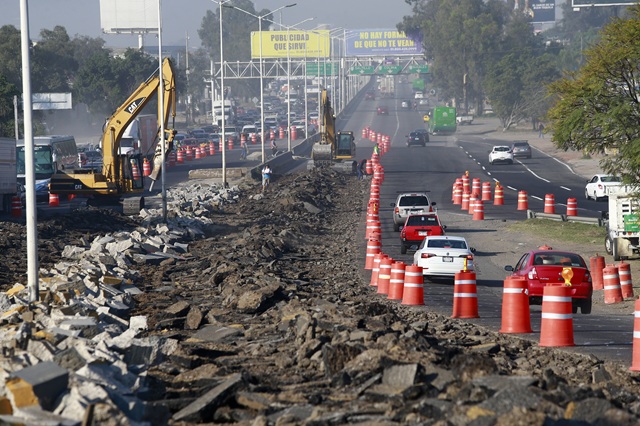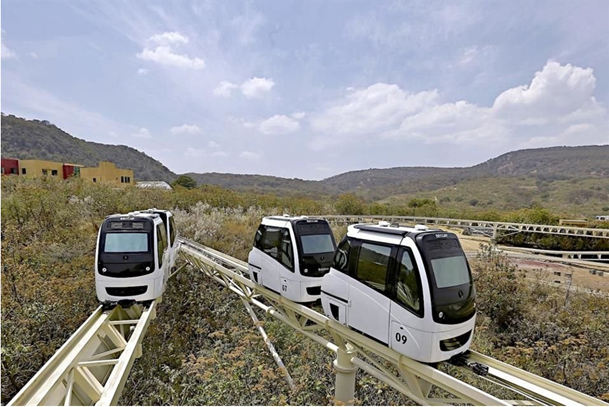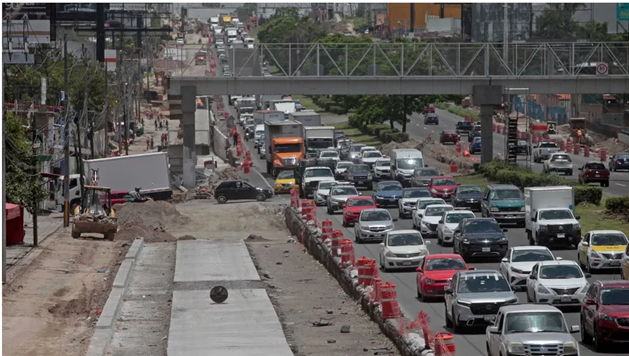With the 2026 World Cup set to kick off in less than seven months, Guadalajara is a sea of torn-up roads, with assorted infrastructure projects underway to improve airport access and mobility around this city of 5 million residents.
If you missed my previous article on the recent massive changes to the GDL airport, you can read it here.
Below, I take a closer look at several of Guadalajara’s biggest infrastructure projects underway, and the prognosis for completion before the World Cup begins next June.
Linea 5 on Carretera Chapala (the road to/from GDL airport)
For as long as I’ve lived in Guadalajara, the Carretera Chapala has suffered from horrific road congestion. This road sits directly east of the airport, running north to Guadalajara and south to Lake Chapala.
A few years ago, a trip to the airport from my home on the north side of Guadalajara took 45-50 minutes. Lately, it’s been impossible to get there in less than 90 minutes. In the colorful (and accurate) words of one local, the Carretera Chapala is “a total clusterf**k” every day of the week.
Anticipating a PR nightmare during the 2026 World Cup, the state government kicked off a project known as “Linea 5” earlier this year. The original concept for the Guadalajara Line 5 was for a traditional Light Rail (Tren Ligero) system, similar to the city’s existing Lines 1, 2, and 3, with a station inside airport property.
What the heck happened to Linea 4, you ask? I’ll get that in a minute.
Fast forward to late 2025: a light rail system with direct access to the airport is, sadly, not what they’re building down on Carretera Chapala. Several months ago, public officials pivoted on the project’s basic concept due to time and budget constraints.
For a time, officials continued to insist the project would be a LRT/BRT hybrid (BRT is short for bus rapid transit). This was derided by many locals as spin, meant to distract from the fact that the initiative was now, simply, an 8.5 km extension of the BRT system along the Chapala highway, using articulated buses on a dedicated lane.
As the public was very much hoping that a light rail connection from the city to the airport would enable most to avoid taking taxis, Ubers, and buses that contribute to heavy congestion on Carretera Chapala, this was a huge disappointment.
But it is what it is.

Last week, in his “State of the State Address” at Hospicio Cabañas, Governor Pablo Lemus surprised many when he declared that eight lanes on the Carretera de Chapala (four in each direction, two more than it had previously) would be open by November 20, 2025. In addition, he said that new sidewalks and a bike path along this route would also be completed no later than December 31 of this year.
That news came as a surprise, given that last month the governor was saying publicly that the Linea 5 project was only about 60% finished.
The BRT System extension using electric buses on a dedicated lane of the Chapala highway will be known as “Mi Macro Aeropuerto.” According to Lemus, this final piece of the project is expected to begin operations no later than April 30, 2026, which is roughly five weeks before the first World Cup game in Guadalajara.
The BRT extension south to the airport is critical to making it easier for the thousands of tourists arriving by plane to reach various points around the city without getting in private cars, Ubers, or taxis. It will reportedly connect to two of the city’s major light rail lines, Linea 1 and Linea 3.
Due to time constraints, Mi Macro Aeropuerto will utilize a temporary station in front of the airport’s international lounge during the World Cup, with a permanent station planned for the airport’s future Terminal 2, which some say will be completed by 2027.

Autotrain Project from Periferico to AKRON Stadium Derailed
Authorized by Zapopan’s City Council last August at a cost of $300 MM pesos (all private funds), the “Autotrain” project was intended to connect Akron stadium – where World Cup 2026 games will be held – to Guadalajara’s bus rapid transit system (BRT) that serves the west side of the city.
It was an ambitious project intended to ferry 7,200 passengers per hour from the Estadio Chivas Mi Macro station (part of Guadalajara’s BRT system along the Periferico ring road) to AKRON Stadium via 15 electrically powered trains along an elevated platform.
Despite the complexity, build time was scheduled to take a mere seven months, with two more allocated to testing and delivery. Unsurprisingly, less than two months after it received the green light, the project was scrapped.
The contractor hired to build it, Modutram México SAPI de CV, told local officials late last month it had no chance of getting the project completed in time for the World Cup.
What Will Be Built Instead
To facilitate foot traffic from the Mi Macro station to AKRON stadium, the city now has plans to construct a walkway with an elevator. In other words, fans will now be traversing the 1.6-kilometer distance on foot, as no one will be permitted to arrive at AKRON stadium for World Cup games by private car.
I’m unsure what that means for anyone who cannot handle the physical challenge, at a time of year when it’s normal for temperatures to exceed 90 degrees Fahrenheit (32 degrees Celsius) in late afternoon.
Just yesterday, President Sheinbaum declared that all federal infrastructure projects for the 2026 World Cup will be completed in time for the start of the tournament next June. These do NOT include Guadalajara’s public works described above, which are state-funded.
We’ll know shortly if the timelines set out by Governor Lemus can be met before the world descends on La Perla Tapatia for the first kickoff.

A Recap of Recent Large Infrastructure Projects in GDL: Planned vs. Actual Completion
I really, really want to be optimistic about these projects getting done well and on time, due to the enormous benefits they would provide to not just futbol tourists but the city’s permanent residents. But the reality is that major infrastructure projects in Guadalajara have a near-perfect record of significant time and cost overruns.
Will the pressure of a looming deadline – the start of World Cup 2026 – break the spell? Below is a recap of Guadalajara’s delivery of recent major infrastructure projects.
Light Rail Line 4
- Construction began in May 2022, with the initial timeline for completion set for March 2024.
- The project has endured repeated delays, with the estimated start date pushed back several times. As of this writing, service is set to start on December 15, 2025, with manual operations and free rides in the initial two weeks.
- Line 4 should be fully operational by February 2026.
Light Rail Line 3
- Original planned completion date: 2016.
- Actual start date: September 12, 2020.
- The project was delayed by several years due to technical issues and changes in government administrations.
Guadalajara – Puerto Vallarta Highway 70D
- Original planned completion date: late 2023
- The build spanned 13 years and involved more than 2,000 workers. Contributing to the delays were land disputes and myriad environmental conflicts.
- Actual opening date: The main route opened on December 31, 2024, with the final part of the project from the La Cruz de Huanacaxtle-Bucerias interchange to the Puerto Vallarta Airport still under construction.
Sources: El Mural, El Informador, Associated Press, Government of Jalisco.

